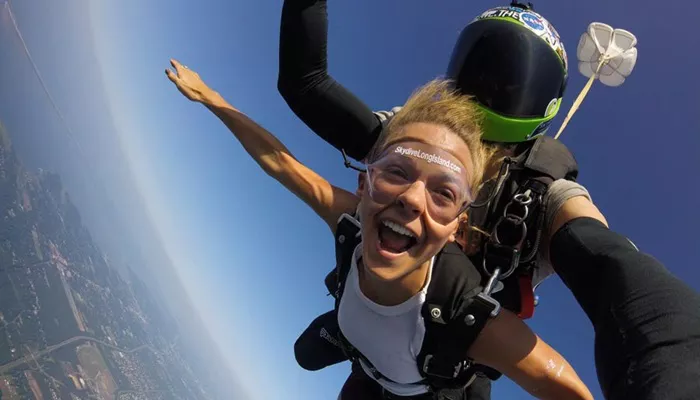Skydiving is often the benchmark of extreme sports. The sensation of free-fall, the sound of air rushing past, and the adrenaline spike as you deploy your parachute—these make Tandem Skydiving a rite of passage for thrill-seekers. But in the world of extreme sports, there are activities that push limits even further. This guide delves into sports considered more intense, dangerous, or mentally demanding than skydiving.
The Thrill Benchmark: Why Skydiving Feels So Extreme
Skydiving is one of the most recognized extreme sports worldwide. When someone jumps from a plane thousands of feet above the earth, they experience a unique mix of excitement, terror, and freedom.
Adrenaline and Perception
Tandem Skydiving introduces beginners to the experience under professional supervision. Despite its safety, it feels extreme because of:
- Rapid descent
- Intense air pressure
- Height perception
- Lack of control
Controlled Environment
Ironically, skydiving has become one of the safest extreme sports due to strict regulations, modern gear, and instructor-led jumps. This raises the question: can other sports surpass it in extremity?
BASE Jumping: Higher Risk, Shorter Time
BASE stands for Building, Antenna, Span, and Earth. BASE jumpers leap from fixed structures, deploying parachutes in seconds.
What Makes It More Extreme?
Unlike skydiving, there’s no altitude buffer. Mistiming your chute means near-certain death.
- Lower exit altitudes (often under 1,000 feet)
- Shorter free-fall windows
- Complex terrains
BASE jumping has a significantly higher fatality rate than skydiving.
Psychological Impact
BASE jumpers must remain composed with almost zero margin for error. The fear and risk are unmatched.
Wingsuit Flying: Human Flight Redefined
Wingsuit flying evolved from skydiving. Athletes wear a specially designed suit that allows horizontal movement during free-fall.
The Danger Factor
Wingsuit pilots can reach speeds exceeding 200 mph while maneuvering through narrow canyons or mountain ridges.
- Split-second decisions
- High precision requirements
- Catastrophic failure rate without experience
Many wingsuit flights begin with BASE jumping, adding to the complexity.
Free Solo Climbing: No Rope, No Return
This sport gained fame from Alex Honnold’s free solo climb of El Capitan. Athletes ascend vertical rock faces without any protective gear.
Beyond the Physical
Free soloing isn’t just a physical challenge; it’s a mental crucible. One slip means death.
- Requires unwavering focus
- Demands elite strength and balance
- No safety equipment
Psychological fortitude separates free solo climbers from most extreme sports participants.
Cave Diving: Pressure and Panic
Underwater cave diving combines scuba diving with tight, unexplored cave systems.
Unique Threats
This sport presents risks that skydiving does not:
- Equipment failure under pressure
- Disorientation in total darkness
- Entrapment hazards
Even experienced divers face life-threatening scenarios with no immediate exit.
Ice Climbing in Remote Regions
Scaling frozen waterfalls and glaciers is both beautiful and brutal. Conditions are unpredictable, and collapse is always a possibility.
Environmental Extremes
Ice climbers face:
- Harsh weather
- Thin air
- Falling ice
Remote settings mean emergency rescue is delayed or impossible.
Highlining: Balance Over the Void
Highlining is tightrope walking across canyons or cliffs, often with minimal safety gear.
What Sets It Apart?
Highliners face:
- Wind gusts
- Visual illusions from heights
- Mental stress
Some highliners remove the leash (free solo highlining), risking death with each step.
Big Wave Surfing: Ocean Fury
Surfing waves over 60 feet tall demands total control and nerves of steel.
Oceanic Dangers
The ocean is an unpredictable, unforgiving opponent. Risks include:
- Drowning
- Impact from board or seafloor
- Being held underwater for minutes
Many surfers compare the sensation to being hit by a truck underwater.
Motorsport: Speed at the Edge of Control
Extreme motorsports such as Isle of Man TT and Dakar Rally blend high speeds with difficult terrain.
Why They’re More Dangerous
High-speed crashes, mechanical failure, and hazardous terrain increase fatality rates. These events often go beyond the structured safety of professional skydiving.
Extreme Mountaineering: Death Zones and Glaciers
Climbers ascending peaks like Everest face hypoxia, frostbite, and avalanches.
Why It’s More Than Just Climbing
Mountaineering tests survival skills. Challenges include:
- Thin air above 8,000 meters
- Long expedition times
- Unpredictable weather
Many climbers die from altitude-related illnesses or exhaustion.
Extreme Endurance Events
Ultramarathons, polar expeditions, and desert crossings push human endurance past its limits.
Extreme in a Different Way
Unlike skydiving’s sudden thrill, endurance events stretch pain over hours or days. The mental and physical toll is immense.
Space Diving: The Final Frontier
Felix Baumgartner’s jump from the stratosphere in 2012 introduced a new level of extreme.
The Edge of Atmosphere
Skydiving from space involves:
- Vacuum exposure
- Supersonic speeds
- Life-support suits
It remains rare but represents a future direction of extreme sport evolution.
Comparing Skydiving and These Extreme Sports
Risk Factor
While Tandem Skydiving is statistically safe, activities like BASE jumping and free soloing carry much higher fatality rates.
Mental Demand
Sports like free solo climbing and cave diving require absolute psychological control, often exceeding the mental demands of skydiving.
Technical Complexity
Wingsuit flying, motorsport, and cave diving demand a high technical skill level. Mistakes are less forgiving than in skydiving.
Why Skydiving Remains a Gateway to Extremes
Despite being less risky than other sports, skydiving serves as a powerful introduction to the extreme sports world.
Accessible Yet Powerful
With Skiing Guide or Tandem Skydiving, adventurers can safely explore their threshold for fear and adrenaline. It’s the perfect stepping stone.
Psychological Testing Ground
Skydiving helps individuals gauge their reaction to high-stress, high-altitude environments—an essential metric before progressing to more dangerous pursuits.
Conclusion
Skydiving remains iconic but is no longer the apex of extreme. From wingsuit proximity flights to highlining across sheer voids, modern extreme sports constantly evolve.
If you’ve conquered the skies and seek more, be warned: the road beyond skydiving is narrower, steeper, and riskier. But for some, that’s exactly the point.

